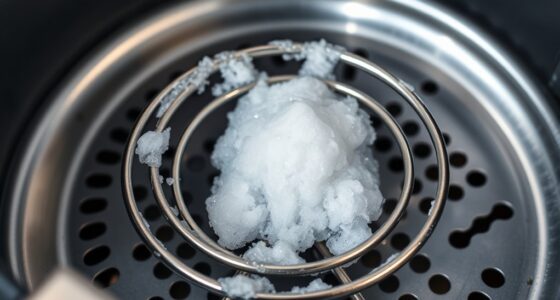To stop your rice cooker from overflowing due to starch, start by rinsing your rice thoroughly to reduce surface starch and foam formation. Use the correct water-to-rice ratio based on your rice type, and avoid overfilling. Selecting long-grain rice or cooked with proper ventilation helps release excess bubbles. Regularly clean your cooker to prevent starch buildup. If you want detailed tips to keep your cooker mess-free, there’s more to try.
Key Takeaways
- Rinse rice thoroughly before cooking to reduce surface starch and foam formation.
- Use proper water-to-rice ratios specific to your rice type to prevent excess foam.
- Avoid overfilling the cooker and ensure the lid fits loosely to allow foam to escape safely.
- Clean the inner pot and lid regularly to remove starch buildup that can cause overflow.
- Monitor cooking and avoid opening the lid prematurely to prevent foam disruption and spills.
Understanding Why Rice Cookers Overflow

When you notice your rice cooker overflowing, it’s often because the starch released during cooking creates foam and bubbles that rise rapidly. As the rice heats, excess starch thickens the mixture, trapping air and forming foam. This foam pushes against the lid and can cause overflow if not managed. Many rice cookers have a cooking timer that helps regulate cooking time, but it doesn’t control foam buildup. Instead, the steam release plays a vital role; if it’s blocked or not working properly, pressure and foam can accumulate. Ensuring your steam release is clear allows excess steam and foam to escape safely, preventing overflow. Additionally, understanding how starch and steam interactions influence foam formation can help you troubleshoot and maintain your rice cooker effectively.
The Role of Starch in Rice Cooker Overflowing

Starch plays a central role in causing rice cooker overflow because it creates foam and bubbles as it heats up. When rice absorbs water, the starch molecules swell and become sticky, leading to increased foam formation during cooking. This starch behavior results in bubbling that can quickly overflow if not controlled. The design of your cooker also influences how well it manages this foam; models with wider lids or vents may allow excess bubbles to escape more easily, reducing overflow risk. Conversely, cookers with sealed, tight-fitting lids can trap foam, causing it to spill over. Understanding how starch acts during heating helps you choose a suitable cooker and adjust your cooking method to prevent messes caused by overflowing starch. Additionally, employing proper water ratios can help minimize excess foam formation and reduce the likelihood of overflowing.
How to Properly Measure Rice and Water
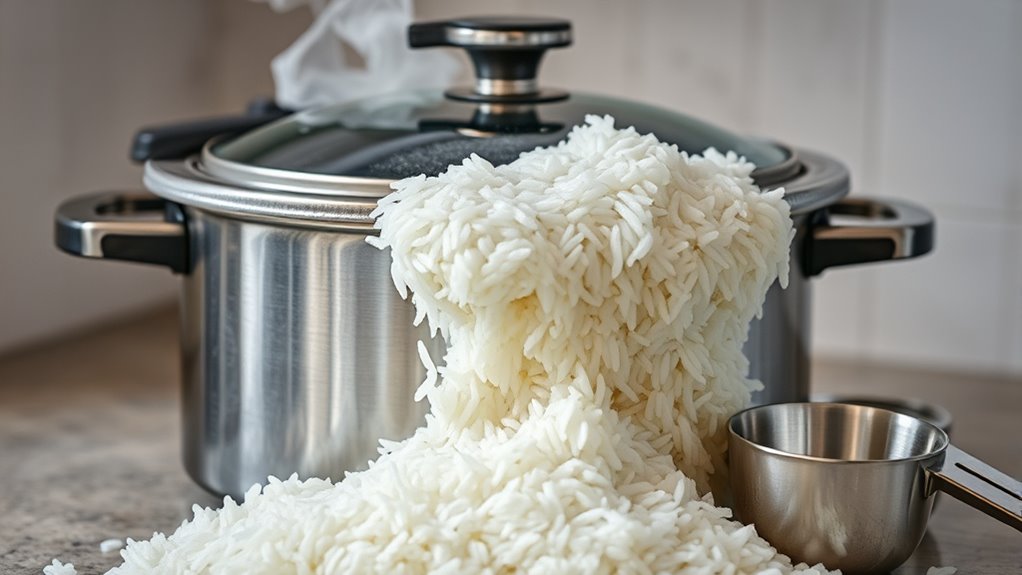
Accurate measurement of rice and water is key to preventing overflowing and ensuring perfectly cooked rice. Use a standard measuring cup for rice, and refer to your rice cooker’s guidelines for water levels. Typically, a 1:1.5 to 1:2 ratio of rice to water works well, but check your rice type and cooking techniques for adjustments. Store rice properly in an airtight container to keep it fresh and avoid moisture issues that can affect measurements. Always rinse rice before cooking if you prefer fluffier results, but remember this can influence water absorption. Consistent measurement helps avoid excess starch buildup, reducing overflow risks. Water absorption rates can vary depending on rice type and cooking conditions, so adjusting your water accordingly is important. By mastering proper rice and water measurement, you maintain cleaner cooking processes and achieve better texture with less mess.
Rinsing Rice Effectively to Reduce Excess Starch
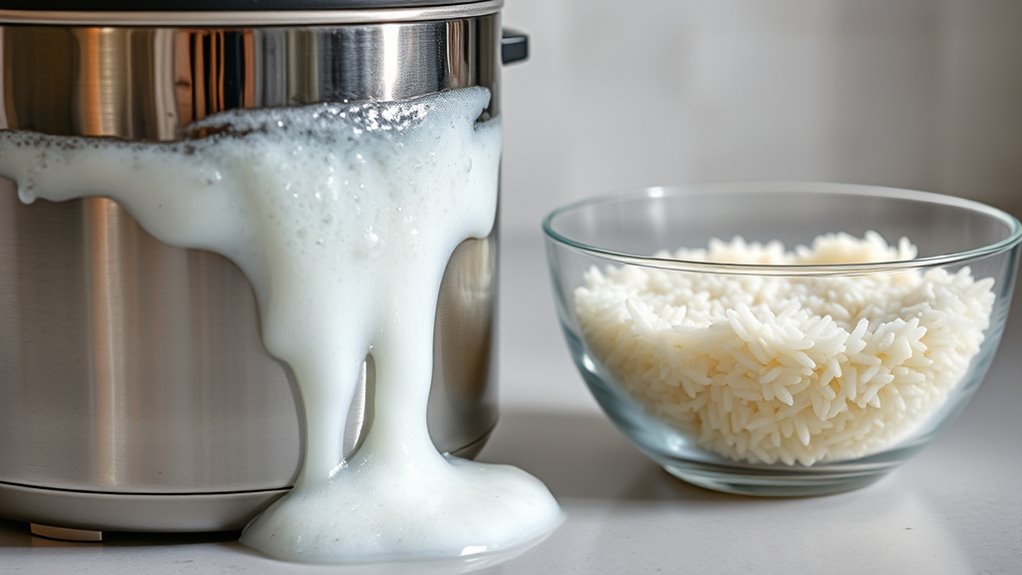
To reduce excess starch, start by rinsing the rice with cold water. Swirl the rice gently, then drain thoroughly to wash away surface starch. Repeating this process guarantees your rice cooks with less stickiness and fewer overflow issues.
Use Cold Water Rinse
Rinsing rice with cold water is an effective way to wash away excess starch that causes overflowing in rice cookers. Cold water helps reduce surface starch, preventing it from sticking together and creating foam during cooking. To do this, place your rice in a bowl or directly in the sink and run cold water over it. Gently swirl the rice with your hand, then drain the water. Repeat this process several times until the water runs clearer. This starch reduction method minimizes foam and mess, making cooking cleaner and easier. Using cold water for rinsing ensures you’re not activating any enzymes prematurely and keeps the rice’s texture light and fluffy. Incorporating this simple step into your routine can also improve the quality of cooked rice, resulting in a more consistent and enjoyable meal.
Swirl and Drain Thoroughly
Before you start draining the water, give the rice a good swirl to loosen and release excess starch. This simple step helps with starch reduction by breaking up clumps and rinsing away surface starch. As you swirl, guarantee the rice moves evenly, preventing stubborn pockets of starch from sticking. When you’re ready, pour out the cloudy water, allowing for thorough water drainage. Repeat this process a few times until the water runs clearer, signaling most surface starch has been washed away. Proper swirling and drainage are key to reducing the stickiness caused by excess starch. This method ensures your rice cooks more evenly, with less mess and fewer overflow issues. Keep rinsing until the water is as clear as possible for ideal results. Additionally, using a headphones with good noise-canceling capabilities can help you focus on perfecting your rinsing technique without distractions.
Choosing the Right Type of Rice for Your Cooker
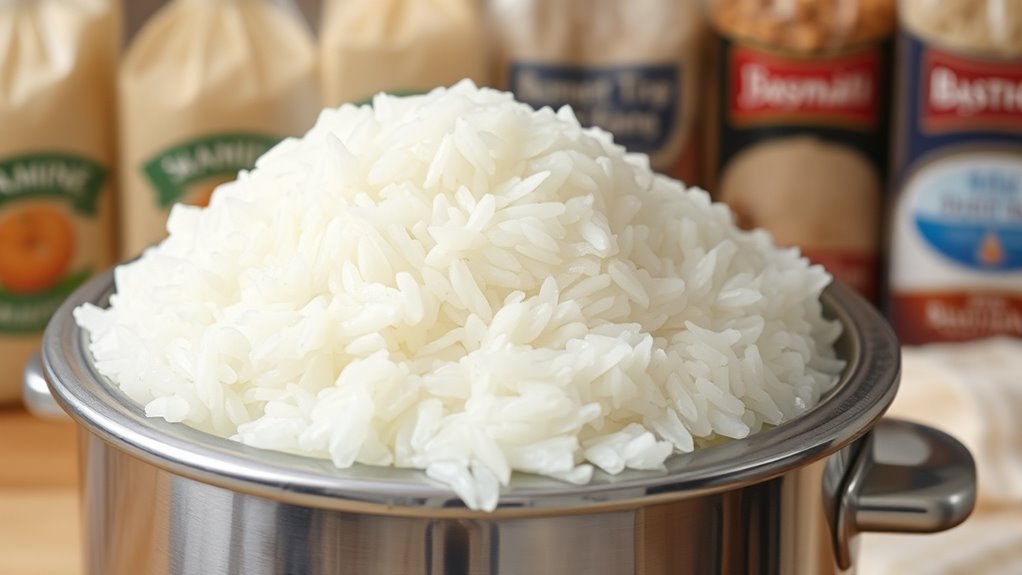
Choosing the right type of rice is essential for preventing overflow and ensuring perfect results in your cooker. Different rice varieties vary in grain texture and cooking time, affecting how they behave during cooking. For example, short-grain rice tends to be stickier, which can lead to more starch buildup, while long-grain rice stays fluffier and separates easily. Consider these points when selecting rice:
- Grain texture: Choose based on whether you want sticky or fluffy rice.
- Cooking time: Adjust cooking time to match the rice type for ideal results.
- Starch content: Higher starch varieties may cause more overflow if not rinsed thoroughly.
- Water absorption rates also influence how much the rice expands during cooking and can impact overflow potential.
Matching your rice choice to your cooker’s settings helps prevent messes and guarantees better, more consistent dishes every time.
Adjusting Water Ratios for Different Rice Varieties
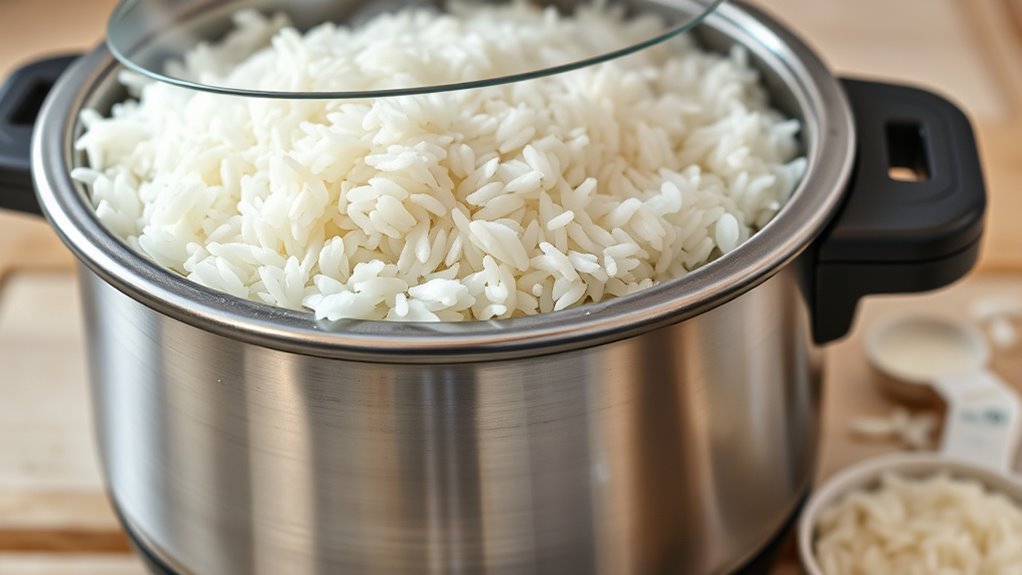
Different rice varieties need different water ratios to cook properly. If you notice your rice is too sticky or too dry, adjusting the amount of water can improve the texture. Experimenting with these ratios helps you get perfect results for each type. Using the right water ratio is especially important when working with varied rice types, as their moisture absorption can differ significantly.
Rice Type Variations
Since various rice varieties have different starch content and grain textures, adjusting the water-to-rice ratio is essential for ideal results. For high-starch varieties like jasmine or sushi rice, use slightly less water to prevent excess stickiness and maintain good grain quality. Long-grain rice generally needs more water to achieve fluffy texture, while short-grain rice benefits from less water to keep it tender without becoming mushy. Keep in mind that different rice types also affect the cooking duration; some varieties cook faster, so adjusting water helps prevent overcooking. Consider these tips to optimize your rice:
- Use less water for sticky, high-starch varieties
- Add more water for fluffy, long-grain rice
- Adjust cooking time based on rice type for perfect texture
- Understanding the starch content of your rice can help in choosing the right water ratio for optimal results.
Water-to-Rice Ratios
Adjusting the water-to-rice ratio is essential for achieving ideal results with your rice cooker, as different rice varieties absorb water differently. For example, short-grain rice tends to be stickier and requires slightly less water, while long-grain rice needs more water to achieve a fluffy texture. If your rice turns out too mushy or too dry, tweak the water amount accordingly. Keep in mind that rice texture directly influences cooking time; more water often means longer cook times, especially for denser varieties. Use the recommended ratios as a starting point, then modify based on your preferences and rice type. Properly balancing water ensures your rice cooks evenly, prevents overflow, and results in a perfect, non-messy batch every time. Additionally, understanding the water absorption characteristics of different rice types can help you fine-tune your cooking process for consistently better results.
Preventative Tips to Avoid Overflow During Cooking
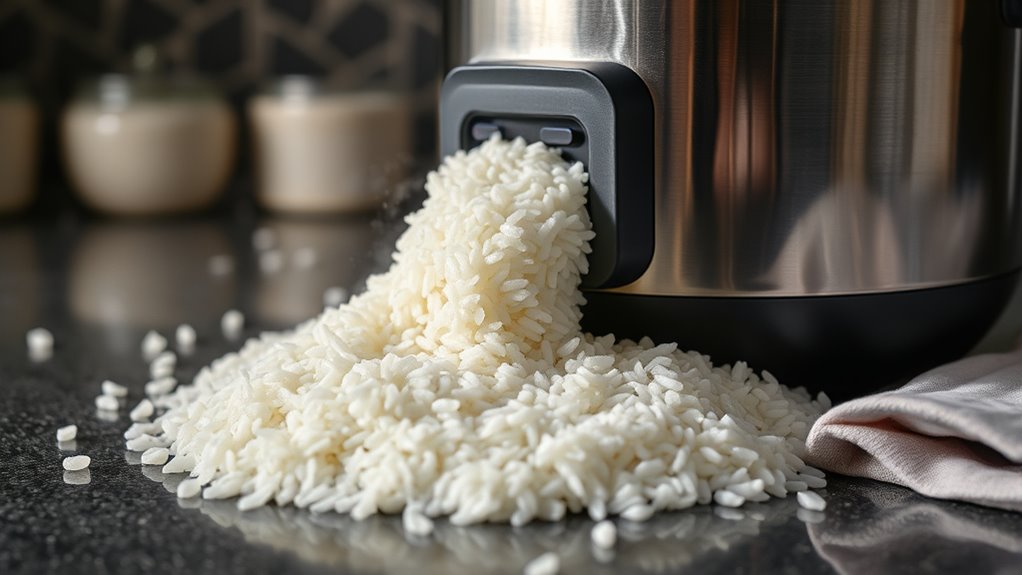
To prevent your rice cooker from overflowing and creating a mess, start by rinsing the rice thoroughly before cooking. This reduces excess starch that causes foaming and spills. Additionally, you can:
Rinsing rice thoroughly helps prevent foam and spills in your rice cooker.
- Use the correct water-to-rice ratio to prevent overflows and promote rice cooker safety.
- Adjust cooking time if you notice excessive bubbling or foaming; shorter cooking cycles can help manage overflow.
- Keep an eye on the cooking process and avoid opening the lid prematurely, which can disrupt the cooking cycle and cause spillage.
- Being aware of automation in kitchen appliances can help you better understand how modern rice cookers are designed to handle such issues and improve your cooking experience.
Implementing these tips helps maintain safety and ensures your rice cooks evenly without messes. Proper adjustments and attentive monitoring are key to avoiding overflow issues and enjoying perfectly cooked rice every time.
Cleaning and Maintenance to Minimize Starch Buildup
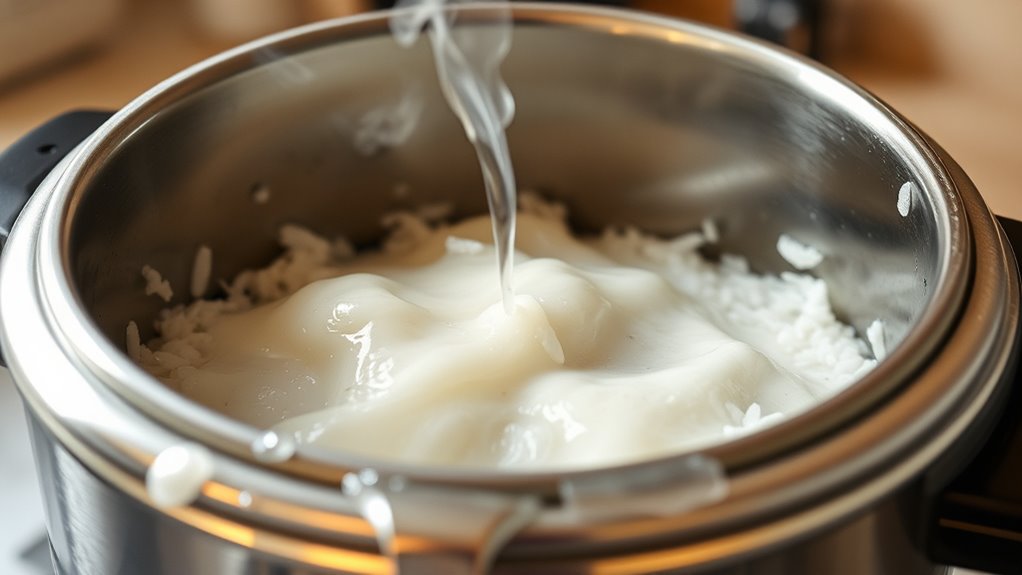
Regular cleaning of your rice cooker is essential for minimizing starch buildup that can lead to overflowing and affect its performance. To achieve this, frequently wash the inner pot with warm water and mild detergent, ensuring all residue is removed. Use rice cooker cleaning tools, like a soft brush or sponge, to scrub away stuck starch, especially around the heating element and lid. Implement starch reduction techniques, such as rinsing rice thoroughly before cooking, to lower surface starch levels. After each use, wipe down the lid and exterior to prevent starch from settling there. Regular maintenance keeps your rice cooker functioning efficiently, reduces overflow issues, and extends its lifespan. Consistent rice cooker cleaning is your best defense against stubborn starch buildup and messy overflows. Additionally, understanding how self-watering plant pots work can help you maintain healthy plants and prevent overwatering, similar to how regular cleaning prevents issues in your rice cooker.
Troubleshooting Common Issues With Rice Cooker Overflow

When your rice cooker overflows, it often signals a specific issue that needs attention. One common cause is incorrect power settings or cooking time. If the cooker is set to high or you’ve added too much water or starch, it can bubble over. To fix this, try adjusting the power settings to a lower level, especially during the simmering phase. Also, check the amount of water and starch you add; overshooting can lead to overflow. Make sure to monitor the cooking time—overcooking can cause excessive bubbling. Additionally, using a quality rice cooker with proper temperature control can help prevent overflows and ensure consistent results. Consider these tips:
- Lower the power setting during cooking
- Reduce the amount of water or starch used
- Adjust cooking time to prevent overboiling
Maintaining proper settings helps prevent messes and ensures perfectly cooked rice.
Frequently Asked Questions
Can Certain Rice Brands Cause More Starch Buildup?
Yes, certain rice brands can cause more starch buildup. Some brands, especially those with higher amylose or different processing methods, release more starch during cooking. This excess starch can lead to overflowing and a mess. To minimize this, rinse your rice thoroughly before cooking and consider choosing brands known for lower starch content. Adjusting water ratios and using a gentle heat setting also helps reduce starch buildup and keeps your rice cooker clean.
Does Using a Lid With a Vent Reduce Overflow?
Yes, using a vented lid drastically reduces overflow, preventing a kitchen catastrophe! When you rely on a vented lid, the steam release escapes smoothly, stopping that explosive mess of starch and water from spilling over. It’s like giving your rice cooker a safety valve. So, always opt for a vented lid — your counter will thank you, and you’ll avoid cleaning up what looks like a rice volcano eruption!
Are There Specific Rice Cooker Models Less Prone to Overflow?
Yes, some rice cooker models are less prone to overflow due to features like non-stick coating and efficient steam venting. Non-stick surfaces make cleaning easier and prevent starch buildup that can cause overflow. Additionally, models with well-designed steam venting regulate pressure and moisture release, reducing spills. Look for cookers with these features when shopping, and you’ll likely experience fewer overflow issues, keeping your kitchen cleaner and rice perfectly cooked.
How Does Altitude Affect Rice Cooker Overflow?
Altitude effects can cause your rice cooker to overflow because pressure changes at higher elevations alter boiling points. When you cook at high altitude, water boils at lower temperatures, which can lead to excess starch and overflowing. To prevent this, you should adjust the cooking time, reduce the amount of water, or use a rice cooker with altitude-specific settings. This helps manage pressure changes and keeps your kitchen mess-free.
Can Adding Oil Prevent Starch From Overflowing?
Adding a little oil can help prevent starch from overflowing your rice cooker, as it creates a thin barrier that reduces foam and bubbles. This oil addition helps contain the starch, keeping it from spilling over during cooking. Make sure to add just a small amount—about a teaspoon—before starting the rice. This simple step effectively minimizes mess and keeps your rice cooker cleaner.
Conclusion
By understanding how starch affects your rice cooker and following simple tips, you can keep the mess at bay. Proper measurement, rinsing, and choosing the right rice make all the difference. Regular cleaning helps prevent buildup and overflow issues. Remember, a little prevention goes a long way—don’t let small problems snowball. With these tricks up your sleeve, you’ll be cooking perfect rice without the fuss, proving that a stitch in time saves nine.



